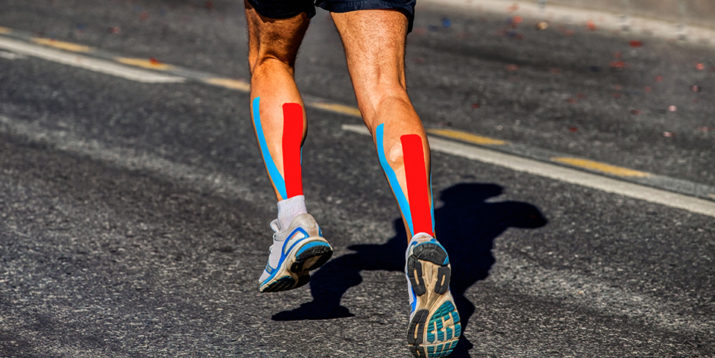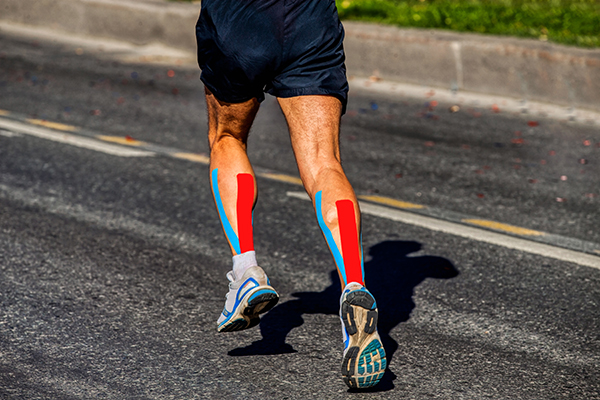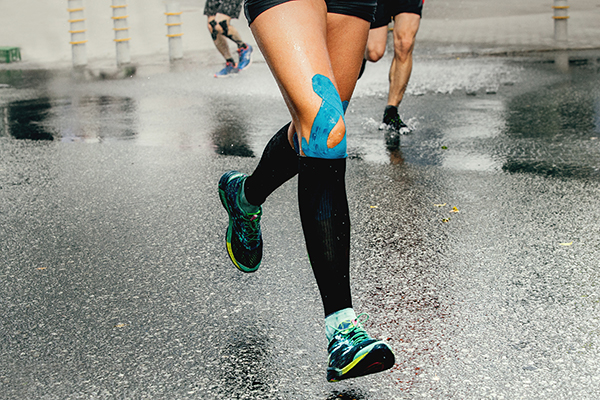What Does KT Tape Actually Do?

What in the world is KT tape?
Maybe your running buddy showed up wearing it. Or you see it on someone at the gym.
Or you’ve been curious since Olympian Kerri Walsh Jennings showed up to a volleyball match with bright blue tape on her shoulder.
Those strips aren’t for aesthetics.
KT Tape (or “kinesiology tape”) is a physical therapy tool.
KT Tape is just one name brand of these colorful, sweat-proof adhesives. Also called kinesio tape, “it’s like tissue versus Kleenex,” Theresa Marko, P.T., D.P.T., M.S., a physical therapist.
Fans claim it provides support and relieves pain, but is it actually the secret to how to work out with a knee injury?
Here’s what experts say.
What Is KT Tape?

“KT Tape is an elastic adhesive tape commonly used to treat musculoskeletal dysfunction,” explains Leada Malek, D.P.T., C.S.C.S., a physical therapist and board-certified sports specialist.
“It is typically stretched a targeted amount and then laid onto an area of musculoskeletal dysfunction,” so you’ll see it running “along a muscle and anchoring near a joint,” she explains.
Marko says that the technical way to use KT tape is to apply it with the intention of “turning on” or “turning off” muscles, to activate them, or to encourage your body to rely on other muscles instead.
How tightly the tape is stretched affects how much tension is put on a targeted muscle, generally speaking.
While KT tape is used to help athletes, it’s not the same thing as athletic tape.
Unlike other tapes you may see in a physical therapy setting, kinesio tape has more stretch to allow you to move through a range of motion.
How Does KT Tape Work?

Theoretically, KT tape is applied to the skin directly over the targeted muscle group, using more or less tension.
More tension prompts your muscles to contract, essentially “turning them on.”
The physical therapist applying the tape knows whether they’re trying to excite or relax a muscle.
They choose a target amount of stretch for the tape, based on that goal and proper anchor points on your body.
Marko says she and other professionals also use it for other purposes, like to help stabilize joints sometimes.
Typically athletic tape or strapping tape would be used, she explains, but kinesiology tape’s stretch allows more freedom of movement, which can be better for some athletes.
But does KT tape work? There’s some debate.
Yes, some studies support its use, but Malek notes that other studies have shown similar effects from a placebo tape.
Even where we have evidence that KT tape helps in some way, researchers still aren’t sure how.
4 KT Tape Benefits

However, there are some limitations to KT tape.
That’s why, says Malek, it’s “best used in conjunction with another treatment like physical therapy and not alone if it is used in treating painful conditions like knee and shoulder pain.”
1. May help boost strength
It’s not actually possible to “turn off” a muscle, but we can excite them or “turn on” a muscle.
Malek explains that studies show that KT tape can encourage a contraction (a.k.a., “turning on” a muscle), “but the method of how is still unknown and the evidence is weak.”
2. May help your body flush excess fluid
Edema happens when blood vessels in your body leak fluid. This fluid accumulates, which causes swelling.
Those who suffer from post-workout puffiness may find that KT tape decreases it — even more than lymphatic massage, one study found.

3. May temporarily reduce pain
“Individual research per condition is limited, Malek explains, but “KT tape with exercise has been shown to help treat plantar fasciitis,” a condition characterized by stabbing pain in the heel.
And one study found that it effectively relieved pain and increased range of motion in people with arthritis in their knees.
Pro tip: These are the best workouts for bad knees.
4. May increase awareness of your body
Some researchers call proprioception our “sixth sense” — it’s just a fancy term for being aware of where your body is and how it’s moving.
Some studies have found that kinesio tape can increase this sense.
Malek explains that the “body perceiving the feedback of the tape with movement” may be why KT tape is able to help some people with painful movements or injuries.
More awareness may mean you’re less likely to try movements that cause pain.
Create a free Beachbody On Demand account and find out how Beachbody’s at-home workouts, nutrition programs, and online community work together to help you reach your health and fitness goals.
